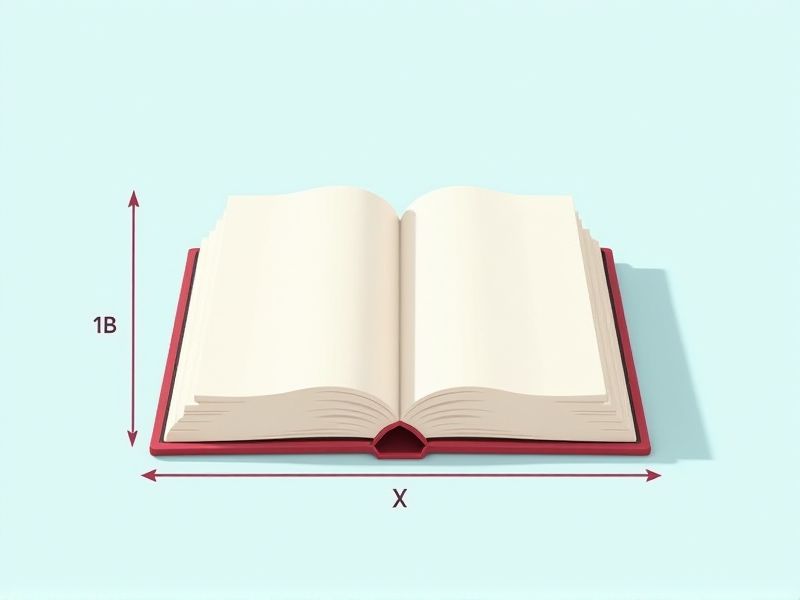
When choosing the standard dimensions for a book, it's helpful to consider common industry sizes to ensure your work looks professional and is cost-effective to print. For example, a typical paperback novel often measures 5" x 8" or 6" x 9", while standard hardcover sizes are usually 6" x 9" or 7" x 10". Children's picture books frequently use larger formats like 8.5" x 11". Selecting a widely-used size not only makes your book more appealing to readers but also simplifies distribution and printing options.
Trim Size
Trim size is a crucial factor in book design, determining the final dimensions of the printed product. Common trim sizes include 5" x 8", 6" x 9", and 8.5" x 11", each catering to specific genres and reader preferences. Your choice of trim size can impact the book's readability, aesthetic appeal, and production costs, influencing both print run and pricing strategy. Understanding these dimensions ensures that your book stands out on shelves and meets industry standards while appealing to your target audience.
Aspect Ratio
Aspect ratio is a critical factor in book design, defining the proportional relationship between width and height. Common aspect ratios for printed books include 5:8, 6:9, and the traditional 8:10, influencing readability and aesthetics. A well-chosen aspect ratio can enhance the visual appeal of your book cover while also impacting the layout of text and images on each page. Consider these dimensions when designing your next publication to ensure optimal reader engagement and comfort.
Page Count
A standard book typically contains between 200 and 400 pages, depending on the genre and target audience; for instance, novels often fall within this range, while academic texts may exceed 500 pages. The page count influences the production cost, with averages varying from $1.50 to $5.00 per copy based on printing quantities and binding types. An increase in page count can also affect retail pricing, which generally ranges from $15 to $30 for trade paperbacks. For readers, a well-paced 300-page book may provide approximately 10 to 12 hours of engaging content, depending on individual reading speed.
Binding Margin
The binding margin is a crucial aspect of book design, typically ranging from 0.5 to 1 inch, depending on the binding method used. This margin ensures that text and images do not get lost in the spine and remain accessible for readers. For instance, a perfect binding may require a larger margin compared to saddle stitch binding to accommodate the thickness of the pages. Pay attention to the binding margin to enhance the visual appeal and functionality of your book.
Bleed Margin
The bleed margin is a critical aspect of book design, typically set at 0.125 inches (3.2 mm) outside the trim line, ensuring that images and graphics extend beyond the final page edge. This design strategy minimizes the risk of white edges appearing on the finished product after trimming. When preparing your print files, it's essential to include this bleed margin, as most printing processes require it to achieve a professional appearance. By adhering to these guidelines, your book will boast a polished look, enhancing its overall visual appeal and professionalism.
Gutter Margin
The gutter margin, typically ranging from 0.5 to 1 inch, is crucial for ensuring readability and aesthetic balance in printed books. This space accommodates the binding and prevents text from being obscured, which can diminish the reader's experience. When designing your book layout, consider the total page count, as thicker books generally require wider gutter margins to maintain legibility. Proper gutter margins enhance the overall professionalism and usability of your book, making it more appealing to readers.
Font Size Compatibility
Font size compatibility in printed books typically ranges from 10 to 14 points, with most publishers favoring 11 or 12 points for body text to ensure legibility. Studies indicate that approximately 70% of readers prefer font sizes between 12 and 13 points, as this range balances readability and aesthetic appeal. For headings and subheadings, a 1.5 to 2 times larger font size is commonly recommended to create a clear hierarchy and improve navigation. When choosing a font size, consider your target audience's preferences, as older readers often benefit from larger text for enhanced readability.
Header/Footer Space
The standard book layout often allocates approximately 0.5 to 1 inch for header and footer spacing, ensuring essential elements like page numbers and titles remain visible without compromising readability. In a typical 6 x 9-inch book, the header may contain the chapter title, while the footer will usually display the page number centrally or aligned right. Maintaining consistent margins enhances the overall aesthetic and accessibility, with recommended settings at around 1 inch for the left and right sides. When formatting your manuscript, pay close attention to these standards to ensure a polished and professional appearance.
Paper Weight
When selecting a book, consider the paper weight, which is typically measured in grams per square meter (gsm). Standard paper weights range from 70 gsm for lighter pages to 150 gsm for thicker, more durable pages. A higher paper weight enhances the quality of the print, providing better opacity and reducing bleed-through, crucial for illustrations or artwork. Choosing the right paper weight not only affects the aesthetics of your book but also its durability, ensuring it withstands frequent handling and use.
Cover Size
When designing a book cover, the standard size for most trade paperbacks is typically 6 inches by 9 inches, which balances readability and aesthetic appeal. For hardcover editions, the common dimensions are often 6.25 inches by 9.5 inches or 7 inches by 10 inches, providing a more substantial presence on shelves. You should consider that the dimensions can significantly impact the overall perception of your book, affecting factors like readability and shelf appeal. Custom sizes, while less common, can create a unique identity for niche markets, allowing your book to stand out in a competitive landscape.
